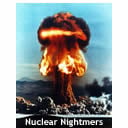
Inside Japan's Nuclear Meltdown
On March 11, 2011, the strongest earthquake to ever hit Japan occurred. It scored a whopping nine on the Richter scale. A devastating tsunami soon followed, with 28,000 people declared dead or missing.
Amongst the hardest-hit areas was Fukushima Prefecture on Japan's eastern coast. Located there was the Fukushima Daiichi Nuclear Power Plant, one of the world's 15 largest nuclear power plants. When the earthquake struck, the staff was concerned but not overly worried. Japan is no stranger to earthquakes, experiencing about 160 earthquakes ranking 3 to 6 on the scale annually. The plant employees were confident that the damage would be minimal. They lost power, but their emergency generators kicked in a few minutes later.
However, the tsunami with its 45-foot waves then slammed into the plant. It flooded all the generators, cutting power, leaving the plant in total darkness. The workers now realized they had a massive crisis on their hands. They had no electricity to run the nuclear reactor's cooling systems. None of the monitoring instruments worked, and they had no idea what was happening inside the reactor. They feared the worst - many remembering Chernobyl. In a moment of sheer genius, the workers ran out to the parking lots and dragged car batteries out of every car they could find. They used all of them to power up the plant's monitoring systems.
At around the same time, Mr Kimura, a local farmer, was frantically searching for his father, wife and youngest daughter. They were swept away by the giant wave that engulfed their town. Many like him had lost their homes and families in the blink of an eye.
Back in the plant, now with instrumentation back online, workers discovered that the nuclear reactor's pressure was too high and on its way to a meltdown. They feared that hydrogen could build up inside the plant and blow it all up. The only way to ease the pressure was to release radiation into the Earth's atmosphere. The plant workers were aware of the consequences, but the alternative was worse. The reactor could explode, blasting nuclear, irradiated fuel and debris over thousands of miles.
The Japanese government, headed by the Prime Minister Naoto Kan, began to coordinate with TEPCO executives, the firm that managed the plant. Both received flak from an outraged public over their response to the crisis.
They soon called for a mass evacuation of everyone in a 12 kilometer radius from the plant. Mr Kimura had to make the difficult decision to flee, along with his surviving daughter, instead of continuing to search for his missing family members.
A chosen group of highly courageous and self-sacrificing plant workers manually opened the vents to cool the nuclear reactor. Members of the Japanese army and the Tokyo Fire Department also came in to help control the situation. They ultimately succeeded in containing what could have been the worst nuclear disaster in human history. Fukushima contained four times the amount of nuclear fuel in its affected reactors than Chernobyl. Failure was not an option.
Directed by: Daniel Edge



